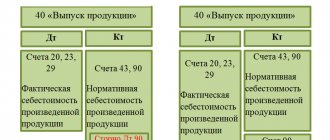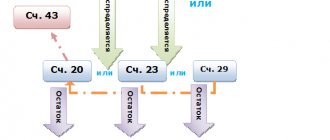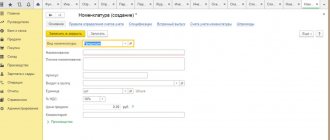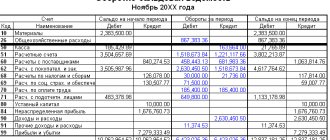What is work in progress?
Work in progress (WIP) is the cost of costs directed to production (general and general production expenses) and other expenses for the production of products, the production of which has already begun, but has not yet been completed at the reporting date (month, quarter, year).
WIP accounting is maintained on production account 20, and can also be maintained on accounts 23, 29 (service production). When closing the reporting period, the resulting debit balances of these accounts indicate work in progress in the organization.
When closing the month (summarizing accounting results), these costs are not written off to other accounts, even if there was no production in the reporting period. In the future, they will be included in the cost of finished products. Until the finished product (service) is sold, the costs will be accounted for as work in progress.
The release of finished products, according to the accounting policy, during the month (production cycle) is estimated at the planned cost. At the end of the month, when closing accounts, the actual cost is calculated when the entire technological process for the production of products or services is completed.
Entering WIP balances into 1C:ERP Enterprise Management
Author of the article: Vera Aleksandrovna Pikuren
She has been working at the Razdolye Exhibition Center since 2005. Currently – Project Manager. She started with the implementation of the 1C:UPP configuration, and since 2015 she has been implementing 1C:ERP. During this time, I successfully launched 6 factories on 1C:ERP. The last project (JSC NPO LEMZ) became the winner of the Corporate Automation Competition “1C: Project of the Year” in the category “Best Project of the Year in the subject area Accounting and Tax Accounting” (https://eawards.1c.ru/projects/1200-rabochih-mest -na-1s-erp-41612/ ).
The article complements the online course “Practical aspects of implementing regulated accounting and cost calculation in 1C:ERP at large industrial enterprises” -
I wrote this article due to the fact that both in our projects and in the projects that we see in the 1C:ERP implementation market, I often encounter issues with the correct entry of initial balances, especially in difficult situations. Currently, I have released a lot of methodological materials on entering initial balances, including a rather convenient table with summary information on which document should be used to enter this or that type of opening balance:
https://its.1c.ru/db/erp24doc#bookmark:remnanttypes:RemnantTypes.
However, some sections of accounting contain a number of nuances that not all consultants know.
In this regard, we have prepared a series of articles on entering balances, where we will analyze them in more detail.
I will consider examples based on the 1C:ERP 2.4.10.93 configuration.
Let's start with the most difficult block - work in progress.
Here is what is written in the table on the ITS:
| Account number | Account name | Documents for entering balances | More details |
| 20 | Primary production | Documents for entering initial balances ( Documents for entering initial balances ( | Remains of work in progress Goods and products in the organization’s own warehouses Balances of unallocated itemized expenses |
| 23 | Auxiliary production | Documents for entering initial balances ( Documents for entering initial balances ( | Remains of work in progress Goods and products in the organization’s own warehouses Balances of unallocated itemized expenses |
| 25 | General production expenses | Documents for entering initial balances ( Other expenses ) | Balances of unallocated itemized expenses |
| 26 | General running costs | Documents for entering initial balances ( Other expenses ) | Balances of unallocated itemized expenses |
| 28 | Defects in production | Documents for entering initial balances ( Documents for entering initial balances ( | Remains of work in progress Goods and products in the organization’s own warehouses Balances of unallocated itemized expenses |
| 29 | Service industries and farms | Documents for entering initial balances ( Documents for entering initial balances ( | Remains of work in progress Goods and products in the organization’s own warehouses Balances of unallocated itemized expenses |
In fact, the technology for entering initial balances will depend on two things: what exactly the client can give you from the old system and what scheme for working with the cost block is chosen for the current project.
The first question is the key one. It is often left at the start of the project development project, but in fact, the issue of residuals should be worked out by consultants at the very initial stage of the project (functional modeling, conceptual design, etc., it is called differently in different companies).
Let's start with material costs, namely, leftovers in the pantries. It is very rare that someone has them in the required 1C:ERP form: name of materials, their quantity and cost. Usually this is still a kind of “cauldron” with some options for maintaining additional records by masters in Excel.
The ideal option for the project is if the customer agrees to conduct an inventory of work in progress and collects the necessary data. But this decision is a big risk for the project, which consultants must, for their part, very carefully plan and monitor. What I mean: production inventory is a complex and slow process. No one will stop the plant just so that our program can be launched easily. A good inventory takes several weeks (and sometimes months), and is usually carried out by workshop: some workshop is stopped for several days and recalculated. You, as IT specialists, need to literally take the production manager by the hand and together with him, step by step, discuss the procedure for each workshop and its deadlines. Convey to him that it will be necessary not only to evaluate work in progress based on the percentage of orders completed, but to recalculate materials and semi-finished products in the workshops.
The peculiarity of the WIP inventory is that usually the members of the commission cannot always independently determine what exactly lies in front of them in the workshop. This is not a warehouse; there are usually no packages with names. Thus, first, the production workers themselves recalculate the work in progress, write labels with the article number, name and quantity on the materials and semi-finished products, which also takes some time. Then the commission members walk around the workshop, collecting these labels, selectively counting the parts. And then this information will still need to be manually entered directly into the program or into Excel for downloading.
I describe the process only to make clear its complexity and, as a consequence, duration. It’s impossible to cover the entire plant at once, so for some workshops you will have balances, for example, on December 20th, and for some – on January 15th. And, accordingly, you, as consultants, will need to come up with a work plan in ERP taking into account such deviations.
And you need to understand that in the end, at the output you will only receive the quantity of the item, according to which you will also need to determine the cost. And this cost will have to coincide with the balances according to regulated accounting that the accountants will give you. You and your economists or accountants need to come up with a scheme to “spread” the amount received from outside over the calculated quantity. At the same time, we should not forget that the amount will most likely be different for accounting and tax accounting, which must be taken into account in the distribution rules. And then, in March, when the accounting department closes the year, you will need to do this exercise again, with the adjusted amount.
Any scheme, be it “distribute according to the planned cost” or “distribute according to the price of the last purchase” will be based on certain assumptions that can lead to distortions in cost when you start writing off inventory items from the workshop storerooms into production. Thus, in order to secure the project, I recommend writing a separate technical specification for the transfer of WIP balances, which should be agreed upon with all services. Among other things, the technical specifications should include an inventory schedule.
After receiving the quantitative and total balances in the system, it is imperative, together with economists, to conduct an audit of 20% of the item items with the highest cost to determine the adequacy of their prices.
Additionally, it is worth noting that with 100% accuracy, WIP is unlikely to be recalculated. There will always be deviations, and even before starting, you need to decide what you will do in the event that workers in the workshop try to write off in the program something that is not listed in the storeroom. A simple and fast reaction mechanism is definitely needed, otherwise the start of the project will be bogged down in unaccomplished “production stage” documents. It’s a bad idea to delete something that interferes with the document, because then the problem will no longer be caught, and as a result of the first cost calculation, you may end up with a part costing 100 rubles instead of 10 thousand, which will undermine confidence in the program.
We usually temporarily allow shop managers to bring inventory items to their storerooms (on the 1st day of the launch month). This, firstly, gives us specific quantitative data on the quality of incoming residues, and secondly, it gives us some time to deal with them without stopping the process.
The point I'm trying to convey is that although formally issuing incoming balances for loading into the new system is the customer's task, it can easily ruin the entire project, so both parties need to take care of this problem.
For enterprises that fulfill government orders, the issue of assigning inventory balances in storerooms to contract numbers should be additionally worked out. Here, too, various options are possible, depending on the enterprise. Usually, if the client did not have such a division in his accounting, then at the entrance to the new system we consider all the materials in the storerooms to be the remainder of the organization, and we already do normal separate accounting from the moment the program is launched.
A more adequate option for the project is if the shop managers still maintain inventory balances somewhere, which can be relied upon when receiving balances. But the problem with the amount of BU and NU that will need to be distributed among them will still remain.
The best option is if, in the old information system, workshop storerooms were maintained in the form of warehouses on 10 units. That is, everything we need is already there: nomenclature, quantity, and cost. If the client is ready to transfer them to the new system at 20k for ease of work, then the balances are first entered precisely as balances to the auxiliary warehouse at 10k on December 31st according to the scheme that will be described below, and on January 1st a document “Transfer of goods” is created, which will transfer leftovers from the auxiliary warehouse to the workshop storerooms. The amount on 20k will appear after the close of January.
So, let’s say that you still received the necessary balances of materials. Now let's look at the technology, how exactly to introduce them into the program.
Balances in warehouses (regular and storerooms) are entered using the document “Entering initial balances”. They are located in the section “Master data and administration” - “Initial filling” - “Documents for entering initial balances”. Documents are entered with the transaction type “Own goods”.
The header of the document indicates the warehouse and division. The department is indicated for reference. In the event that the balances are entered into the workshop storeroom, then the unit will be put into motion precisely from the storeroom details, and not from the department that you indicated in the header of the document.
The document also indicates the type of activity for VAT purposes and the batch. If the first one is clear, then let's look at the game in more detail.
A batch can be either an internal invoice or a supplier invoice.
If an organization keeps records using FIFO, then the purpose of the batch is clear - it determines the date of receipt of inventory items at the warehouse. If in the old system there is where to get this information, then for each receipt it will be necessary to create a separate document for entering initial balances. If we are dealing with storerooms, then usually the information about the batch has already been lost, and then, in principle, it is possible to “plant” the balances into one batch, having previously discussed this with the chief accountant.
If an organization maintains average accounting, then the issue of specifying batches will depend on whether it maintains separate VAT accounting.
For cost accounting purposes, in the case of an average batch, a batch is not needed; balances can be entered in one batch. But for the purposes of separate VAT accounting, data on the batch is written to the accumulation register “Detailing of batches of goods for VAT and simplified tax system”, on the basis of which VAT will be restored in the event that inventory items are transferred between different types of activities. If such a situation is possible, then it is necessary to enter balances in the context of invoices, even in the case of accounting using the average. We will consider entering balances for VAT purposes in more detail in a separate article.
Now let's consider the option when the company is not ready to conduct an inventory. All you have as input are several cost items with amounts. For ERP, this is a very complex situation that requires step-by-step elaboration not so much from the point of view of the technology for entering balances, but from the point of view of the further operation of the system.
It’s good if material costs have already been assigned to some order for 20k. Then the balances for them are entered as a regular itemized expense, which I will talk about later. In this case, work with stages in the new system is built only according to the new nomenclature, which will begin to be transferred to the storerooms, and itemized costs hang on the order, awaiting releases. At the same time, it is necessary to understand that in reality the total 20k in accounting are specific inventory items that are in the workshop. And it is unlikely that a worker who will reflect in 1C the consumption of materials at the production stage will be able to distinguish what he received according to the new scheme from the initial balance. Thus, you, together with economists and production workers, need to immediately agree on what the operator will do in the program when some inventory items in the storerooms are not enough in the accounting, although in fact they are. Here you can consider the option of deleting such lines (assuming that the consumed inventory items have actually already been written off as costs in the previous IS), but you must understand that this decision will inevitably lead to large imbalances between the costs of the stages. If the production cycle is short, and the transitional stages will close within a few months, then this situation can be tolerated.
As an option, you can propose to allow all missing inventory items to be sent to the shop managers, and at the end of the month they will figure out from which stages the “extra” inventory items should be removed - here it all depends on the specific enterprise. But in any case, it is better to start working on this issue at the very start of the project, so that the operators in the workshop have two instructions at once: for the transition period and permanent.
The most difficult option for a project is when the WIP at the input is the notorious “boiler”, which now somehow needs to be transferred to the program logic. Here I would take this path (in terms of material costs):
- Enter the entire cost of materials as itemized expenses using a manual operation Dt 20 <Item entry of remaining materials> KT 000.
- Allow shop managers to capitalize inventory items that are missing in accounting. Receive inventory at the price of the last purchase or the average cost under the old program. In the “Capitalization” document, manually set the postings Dt 20 <storeroom, item> Kt 20 <Item for entering remaining materials>, because the program, of course, does not automatically allow you to receive materials at the expense of work in progress.
Such a scheme requires further elaboration from the point of view of maintaining management accounting (managerial balance sheet, etc.), but here everything will depend on the type of enterprise and project.
In addition, let me remind you about reports. We must not forget to discuss with the customer that he will be able to obtain a normal plan-actual cost analysis only after the transitional stages in the system are closed. Until this point, part of the material costs can be compared with the specification, and part will be shown by the system in the form of itemized costs. Usually customers are fine with this, otherwise they would have to give us not just the materials that are in production, but those that were installed on the products in the work in progress. I have not yet come across factories that kept such records. But if you suddenly come across them, then in ERP you can enter the following balances too:
Such balances in 1C:ERP are entered into the program by the document “Initial WIP balances by production batches” on the “Materials and Works” tab.
The document indicates the batch, nomenclature, its quantity and cost.
The document generates movements in the “Cost of Goods” register in the “Work in Progress” accounting section.
The document is entered separately for each division and area of activity. Since I usually implement ERP at factories that carry out state defense orders, the area of activity there is a Contract with the customer. Stages of production are usually carried out under certain Contracts, and, accordingly, belong to a certain area of activity. That is, my input of initial balances will be divided not only into divisions, but also into contracts.
The document writes tasks in the RS “Tasks for cost calculation” and “Tasks for closing the month. Formation of financial results." The latter needs to be deleted, but the cost calculation for December will need to be performed.
When performing a month-end closing, the task to generate a financial result will still appear after reflecting the initial balances in regulated accounting. You will need to go to the list of documents “Routine operation”, mark the December ones for deletion and then again clear the entries in the PC “Tasks for closing the month”.
Now let's return to the document, namely the production batch. For 1C:ERP, this is a “Stage” document generated on the basis of a Production Order. One of the most creative challenges when entering WIP balances is to figure out how to transfer the cost collection object in the old system into our stages. It is impossible to give any universal solutions here. The main recommendation is to make this retranslation as transparent and simple as possible. It is better to avoid any complex distributions of incoming amounts between stages, because any distributions will lead to cost imbalances between stages, which will then be difficult to explain to the customer. It is much easier to attribute incoming WIP, for example, to the last stage (to the finished product itself), and leave semi-finished products without WIP, highlighting them in batches in accounting. But, I repeat, it all depends on the specific enterprise.
Now let's move on to labor costs. We typically enter these as itemized expenses. Even if the customer has information in the old system about how much and what types of work have already been spent on completing a particular order, this data rarely coincides with the balances of work in progress according to regulated accounting.
However, if you come across an enterprise with ideal accounting, then you can also enter the labor costs spent on the order using the document “Initial WIP balances by production batches” on the “Labor costs” tab.
The document indicates the batch, type of work, quantity, price, and actual cost.
A separate document is introduced for each division, as well as for each area of activity.
The document writes tasks in the RS “Tasks for cost calculation” and “Tasks for closing the month. Formation of financial results." The latter needs to be deleted, but the cost calculation for December will need to be performed.
When executed, the document generates entries in the RN “WIP Labor Costs” with filling in the quantity, standard and actual cost.
Debit entries to the document are established according to the department's accounting account with details by type of work.
The last block of costs is itemized costs. And here again, in customer accounting, two different options are possible: he may have costs already tied to order numbers. Or again an incomprehensible “boiler” that must somehow be made to work in the system.
In our projects, fortunately, the first option is mostly encountered.
Itemized costs that have already been allocated to orders are also entered using the document “Initial balances of work in progress by production batches” on the “Other expenses” tab.
A separate document is introduced for each division, as well as for each area of activity.
The document writes tasks in the RS “Tasks for cost calculation” and “Tasks for closing the month. Formation of financial results." The latter needs to be deleted, but the cost calculation for December will need to be performed.
When carried out, movements are generated in the RN “Other expenses of work in progress”
Debit entries in the document are established according to the department's accounting account, and not according to the expense item.
If you are faced with a “boiler”, then the best option is to first “scatter” the costs across open orders. Here the options for the development of events depend on the enterprise. For example, on one of the projects we took the following route: we collected the entire list of orders that were listed in the work in progress and calculated their cost based on the planned cost. We asked the production manager for the percentage of completion for each order. Based on it and the planned cost, we calculated the current estimated cost of the order, and distributed the WIP in proportion to it. Here I note that since this procedure is rather unobvious from the point of view of regulated accounting, it is reasonable for the consultant to request such balances of work in progress in paper form, signed by some responsible person.
Another option for analyzing the “boiler” that may occur is also based on the planned cost: in the system we begin to work with rolling orders, as usual. And at the time of production of the stage, the accumulated costs are compared with the planned cost. And if the amount for some expense items is less, then it is taken from the incoming boiler. I would like to note right away that this option is being implemented through the modification of 1C:ERP, and in principle it is not recommended by me, because it is an adjustment of the actual cost of production to the planned one.
So, I hope that this article has given you an idea of how to work with the initial balances of 1C:ERP, what problems you may have to face, and why this issue needs to be worked out from the very beginning of the project.
Next, we plan to continue the series of articles with other problematic accounts: VAT, reserves, etc.
We discuss many other complex issues of implementing regulated accounting and cost calculation at industrial enterprises in detail in the course: “Practical aspects of implementing regulated accounting and cost calculation in 1C:ERP at large industrial enterprises” -
How to reflect work in progress in 1C 8.3
In the 1C 8.3 program, select the Accounting parameters section:
Next, it is necessary to indicate on the Production tab that accounting for finished products during the month will be carried out at planned prices:
Using the More button, you can find out how to fill out bookmarks correctly in the Help section:
The main documents on production operations in 1C 8.3 are located in the Production section:
Open this section and select in it those subsections that are necessary to perform certain operations for accounting:
Examples of direct production costs
The “Requirement-invoice” document (menu or “Production” tab) reflects the write-off of materials for production.
The cost account and analytics are listed on the Cost Account tab. When posting the document, posting Dt 20.01 Kt 10 will be generated, with the corresponding analytics for account 20 (division, item group, cost item). Method of reflecting depreciation expenses (menu or tab “OS” or “Intangible assets”). If you choose this method when accepting a fixed asset for accounting (accepting intangible assets for accounting, transferring work clothes into operation), then depreciation for this fixed asset (depreciation of intangible assets, repayment of the cost of work clothes) will be assigned to the specified account and cost analytics. In this case, the posting Dt 20.01 Kt 02.01 will be generated.
Method of reflecting wages in accounting (menu or “Salary” tab). If you specify this method in the accrual, the employee’s salary and payroll taxes will be charged to the appropriate account and cost analytics. In this case, when accruing salary, the posting Dt 20.01 Kt 70 will be generated.
At the end of the month, direct expenses collected on accounts 20 and 23 are distributed between manufactured products and work in progress by item groups (types of activity). Distribution occurs through routine month-end closing operations.
In addition, there are general production and general business expenses, which are accounted for in accounts 25 and 26, respectively.
General production expenses during the month are charged to account 25. To reflect them, the same documents can be used as to reflect direct costs. At the end of the month, costs collected on account 25 are distributed to account 20 by item groups (types of activity), within a specific division, in accordance with the distribution base, using routine operations.
General business expenses during the month are charged to account 26. To reflect them, the same documents can be used as to reflect direct costs. At the end of the month, expenses collected on account 26 can be written off in two ways. They can be distributed to account 20 according to item groups (types of activity) of the entire enterprise, in accordance with the selected distribution base. Or, if the “direct costing” method is used, general business expenses are written off directly to account 90.08 “Administrative expenses” in proportion to sales revenue.
Cost accounting is set up in the form of the organization’s accounting policy (menu or “Enterprise” tab).
On the “Production” tab, the methods for distributing general and general production expenses are indicated using the “Set distribution methods...” button. In the form that opens, you need to indicate for each account the distribution base, which can be the volume of output, the planned cost of production, wages, material costs, revenue, direct costs, and individual items of direct costs. If necessary, you can detail the methods of distribution by departments and cost items.
Here you can configure the use of the direct costing method and the distribution of production costs for services.
On the “Product Output” tab, you select the method of accounting for the output of finished products (semi-finished products, production services) - with or without using account 40. Here you must also specify the definition of the sequence of redistributions for closing accounts, which is important for multi-distribution production. It is recommended to select automatic detection. If production is accounted for at planned cost using account 40, then automatic calculation of the sequence of redistributions is impossible. In this case, you need to select the manual method, and then manually set the order of divisions for closing accounts (using the button).
Automatic determination of the sequence of processing steps is set:
A manual determination of the sequence of repartitions has been set, the order of divisions has been established:
Inventory of work in progress
The WIP Inventory report includes the balances of work in progress at the end of the month, which are not automatically calculated in the 1C 8.3 program.
For these purposes, the 1C 8.3 program provides for the entry of operations “manually” in the context of each item group. In this case, the amounts that we enter manually must first be calculated, then compiled into a table and the WIP result displayed. Then you can enter them into the 1C 8.3 database. For example, the calculation of the amount in work in progress (WIP) can be presented in the table:
Click the Create button to open the accounting document:
Using the Add button from the Nomenclature directory, select the type Curtains and enter the calculated amount of work in progress:
How to correctly write off the balances of finished products from work in progress
And this balance is subject to write-off Dt 20 (23) Kt 28, t.
The defect can be:
- irreparable - then losses from defects are calculated on account 28 “Defects in production” and the main point in the calculation is the write-off of work in progress for defects: Dt 28 Kt 20 (23) - the costs of creating products (semi-finished products) recognized as irreparable defects are written off.
- correctable - then the costs of correcting it can be calculated on cost accounts (for example, according to Dt 20) and then directed to the cost of finished products (Dt 40 (43) Kt 20);
It is noteworthy to write off the final calculation result from account 28 (the account should not have a balance at the end of the period).
e. WIP increases again, and then the cost of finished products. Summary Write-off of work in progress has its own characteristics if there are changes in the normal course of the production process. WIP for the cost of finished products.
Inventory of work in progress. Inventory act. Reflection of surpluses and shortages
The assessment of work in progress is carried out using the method: Actual costs incurred (for single production).
Actual cost is the most reliable and common method. The volume of work in progress is determined. After which its quantity is multiplied by the average unit cost, thereby determining the actual production cost of all work in progress at the end of the month.
Standard cost – applicable for serial and mass production of products. The accounting price per unit of work in progress is applied. Additionally, records are kept of deviations of the planned cost from the actual cost.
For direct cost items - the price of a unit of work in progress is calculated by summing up the direct costs of its creation.
Calculation of unit cost of production in 1C 8.3
To understand how in 1C 8.3 Accounting 3.0 the accumulation of amounts on the balance of production accounts (20, 23, 29) occurs, you must first understand how they are formed. To do this, it is necessary to carry out monthly closure of accounts in the 1C 8.3 database - 20; 23; 25; 26 via the Operations tab in the main menu:
When closing accounts 20, 23, 25, 26 in 1C 8.2 (8.3), the error “Production cost division not specified” may occur. How to eliminate this error and correctly close the month, see our video tutorial:
As a result, 1C 8.3 will generate a Help-calculation sheet for product cost calculations, which reflects the balances of work in progress:
From this certificate we determine the cost per unit of manufactured products, that is, what the final cost of one product (one piece, one service) turned out to be.
We divide all accumulated expenses (costs of raw materials, wages, transportation services, all taxes, advertising costs, etc.) on production (auxiliary, service) accounts by the total output of products (services) and ultimately get the cost of one unit.
In our example, to the main production costs for May, we add the amount of the WIP balance as of May 1 and subtract the amount of the WIP balance as of May 31 - we get the actual cost of manufactured products:
- 44,462.25 +65,100.00 -4,405.25=105,157.00 rub.;
- A total of 20 curtains were produced;
- 105,157.00/20=5,257.85 rub. - calculation of the actual cost of one curtain or its production cost, that is, the 1C 8.3 program calculated how much it cost the company to produce this curtain.
How to take into account the write-off of illiquid inventory items in accounting
The chart of accounts for the accounting of financial and economic activities of organizations, approved by Order of the Ministry of Finance of Russia dated October 31, 2000 N 94n (hereinafter referred to as the Chart of Accounts), for accounting for the decrease in the value of inventory and materials as a result of their damage, as well as for writing off the entire cost of valuables when they are destroyed, account 94 is intended “Shortages and losses from damage to material assets.” This account is used for interim accounting of the cost of inventory items subject to write-off.
Depending on the circumstances surrounding such a write-off, the cost of inventory items can be attributed (Instructions for using the Chart of Accounts for accounting financial and economic activities of organizations (approved by Order of the Ministry of Finance of Russia N 94n)):
- for production expenses or sales expenses when writing off the cost within the limits of natural loss norms during the production, storage or sale of inventories (clause 58 of the Methodological Instructions, paragraph 3 of the Methodological Recommendations for the development of natural loss norms, approved by Order of the Ministry of Economic Development of Russia dated March 31, 2003 N 95 );
- on account of other settlements with personnel in cases where the amount of damage is attributed to the guilty persons from among the organization’s employees;
- against other expenses, if the perpetrators are not identified.
If damage to material assets is recognized as an insured event, the organization separately takes into account the amount of insurance compensation as other income (clause 7, 10.2 of section III of the Accounting Regulations “Income of the Organization” PBU 9/99 (approved by Order of the Ministry of Finance of Russia dated 06.05.1999 N 32n)). If the organization provides for the creation of a reserve for the depreciation of inventory items, their value is written off at the expense of this reserve. It should be noted that the formation of a reserve for a decrease in the cost of inventory and materials is a mandatory requirement for all organizations, except those that are granted the right to use simplified methods of accounting (paragraph 2 of clause 25 of the Accounting Regulations “Accounting for inventories” PBU 5/ 01 (approved by Order of the Ministry of Finance of Russia dated 06/09/2001 N 44n));
- directly to the profit and loss account in case of losses arising from natural disasters, if such are not subject to compensation.
How to find out the total amount of work in progress for a period
Finally, in order to find out the total amount of work in progress for the required reporting period (month, quarter, year), in the 1C 8.3 program, SALT is generated for account 20 in the Reports section:
The balance on the Dt account reflects the cost of manufactured (released) products - this is the amount of work in progress that did not have time to be transferred to the warehouse as finished products.
Our distance learning course on working in 1C: Accounting 8th edition will help you study the mechanism for determining the amount of work in progress at the end of the month in 1C 8.3 for accounting and for NU, correctly calculating the actual cost of finished products and calculating it automatically using the Month Closing procedure . 3.0, module Production of finished products. For more information about the course, watch the following video:
Give your rating to this article: (
4 ratings, average: 3.50 out of 5)
Registered users have access to more than 300 video lessons on working in 1C: Accounting 8, 1C: ZUP
Registered users have access to more than 300 video lessons on working in 1C: Accounting 8, 1C: ZUP
I am already registered
After registering, you will receive a link to the specified address to watch more than 300 video lessons on working in 1C: Accounting 8, 1C: ZUP 8 (free)
By submitting this form, you agree to the Privacy Policy and consent to the processing of personal data
Login to your account
Forgot your password?
Output
We will arrange the release of products. We will write materials according to specifications
- Date: 01/30/2015
- Cost division: Production department
- Products: Yolka
- Quantity: 100
- Planned price: 1000 rubles.
- Accounting account: 43
- Specification: Christmas tree Branch - 1200 pieces
- Needle - 60,000 pieces
- Barrel - 100 pieces
- Small cone - 600 pieces
We will arrange the release of products. We will write materials according to specifications
- Date: 01/31/2015
- Cost division: Production department
- Products: Pine
- Quantity: 110
- Planned price: 1100 rubles.
- Accounting account: 43
- Specification: Pine Branch - 1,980,000 pieces
- Needle - 165,000,000 pieces
- Barrel - 110,000 pieces
- Large cone - 1,100,000 pieces
Thus, the 1C Accounting 8 program reflects production and production operations. You can proceed to completing independent practical tasks.







